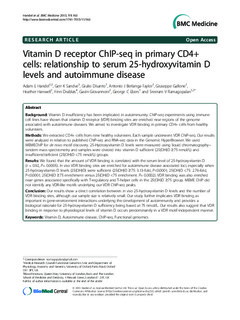| dc.contributor.author | Handel, Adam E | |
| dc.contributor.author | Sandve, Geir Kjetil | |
| dc.contributor.author | Disanto, Giulio | |
| dc.contributor.author | Berlanga-Taylor, Antonio | |
| dc.contributor.author | Gallone, Anna | |
| dc.contributor.author | Hanwell, Heather EC | |
| dc.contributor.author | Drabløs, Finn | |
| dc.contributor.author | Giovannoni, Gavin | |
| dc.contributor.author | Ebers, Georg C | |
| dc.contributor.author | Ramagopalan, Sreeram V | |
| dc.date.accessioned | 2019-10-25T08:36:41Z | |
| dc.date.available | 2019-10-25T08:36:41Z | |
| dc.date.created | 2013-09-06T12:45:09Z | |
| dc.date.issued | 2013 | |
| dc.identifier.citation | BMC Medicine. 2013, 11 (163), . | nb_NO |
| dc.identifier.issn | 1741-7015 | |
| dc.identifier.uri | http://hdl.handle.net/11250/2624371 | |
| dc.description.abstract | Background
Vitamin D insufficiency has been implicated in autoimmunity. ChIP-seq experiments using immune cell lines have shown that vitamin D receptor (VDR) binding sites are enriched near regions of the genome associated with autoimmune diseases. We aimed to investigate VDR binding in primary CD4+ cells from healthy volunteers.
Methods
We extracted CD4+ cells from nine healthy volunteers. Each sample underwent VDR ChIP-seq. Our results were analyzed in relation to published ChIP-seq and RNA-seq data in the Genomic HyperBrowser. We used MEMEChIP for de novo motif discovery. 25-Hydroxyvitamin D levels were measured using liquid chromatography–tandem mass spectrometry and samples were divided into vitamin D sufficient (25(OH)D ≥75 nmol/L) and insufficient/deficient (25(OH)D <75 nmol/L) groups.
Results
We found that the amount of VDR binding is correlated with the serum level of 25-hydroxyvitamin D (r = 0.92, P= 0.0005). In vivo VDR binding sites are enriched for autoimmune disease associated loci, especially when 25-hydroxyvitamin D levels (25(OH)D) were sufficient (25(OH)D ≥75: 3.13-fold, P<0.0001; 25(OH)D <75: 2.76-fold, P<0.0001; 25(OH)D ≥75 enrichment versus 25(OH)D <75 enrichment: P= 0.0002). VDR binding was also enriched near genes associated specifically with T-regulatory and T-helper cells in the 25(OH)D ≥75 group. MEME ChIP did not identify any VDR-like motifs underlying our VDR ChIP-seq peaks.
Conclusion
Our results show a direct correlation between in vivo 25-hydroxyvitamin D levels and the number of VDR binding sites, although our sample size is relatively small. Our study further implicates VDR binding as important in gene-environment interactions underlying the development of autoimmunity and provides a biological rationale for 25-hydroxyvitamin D sufficiency being based at 75 nmol/L. Our results also suggest that VDR binding in response to physiological levels of vitamin D occurs predominantly in a VDR motif-independent manner. | nb_NO |
| dc.language.iso | eng | nb_NO |
| dc.publisher | BMC (part of Springer Nature) | nb_NO |
| dc.rights | Navngivelse 4.0 Internasjonal | * |
| dc.rights.uri | http://creativecommons.org/licenses/by/4.0/deed.no | * |
| dc.title | Vitamin D receptor ChIP-seq in primary CD4+ cells: relationship to serum 25-hydroxyvitamin D levels and autoimmune disease | nb_NO |
| dc.type | Journal article | nb_NO |
| dc.type | Peer reviewed | nb_NO |
| dc.description.version | publishedVersion | nb_NO |
| dc.source.pagenumber | 11 | nb_NO |
| dc.source.volume | 11 | nb_NO |
| dc.source.journal | BMC Medicine | nb_NO |
| dc.source.issue | 163 | nb_NO |
| dc.identifier.doi | 10.1186/1741-7015-11-163 | |
| dc.identifier.cristin | 1047502 | |
| dc.description.localcode | © 2013 Handel et al.; licensee BioMed Central Ltd. This is an Open Access article distributed under the terms of the Creative Commons Attribution License (http://creativecommons.org/licenses/by/2.0), which permits unrestricted use, distribution, and reproduction in any medium, provided the original work is properly cited | nb_NO |
| cristin.unitcode | 194,65,15,0 | |
| cristin.unitname | Institutt for klinisk og molekylær medisin | |
| cristin.ispublished | true | |
| cristin.fulltext | original | |
| cristin.qualitycode | 1 | |

